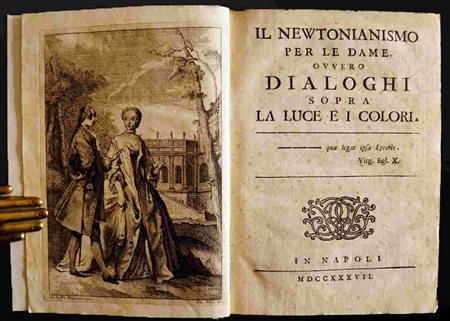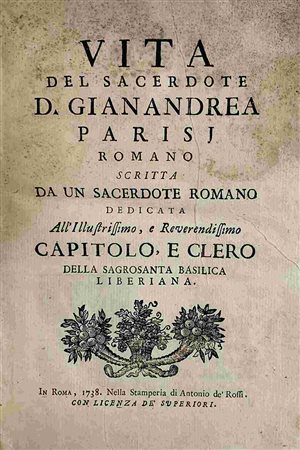WEB AUCTION 118 - LIBRI E AUTOGRAFI
-

Lot 195 FRANCESCO ALGAROTTI (1712-1764)
Il Newtonianismo per le dame, ovvero dialoghi sopra la luce e i colori. In Napoli (but Milan), no printer, 1737
§ 4to (15,5x21x2,5 cm.); XII,pp, missing, as usual, the last leaf of errata. Signature: *1-6, A-Z1-4, Aa-Oo1-4, Pp1-2. Engraved frontispiece by Giovan Battista Piazzetta (1683-1754), engraved by Giuseppe Filosi. Slightly later half-vellum, gilt title-piece on spine. Frontispiece from the 2nd edition (1739); in the first edition was present the same illustration by Piazzetta, but engraved by Pitteri. Occasional foxing in places, but fine copy.
First edition, published without the required permissions and with a forged imprint place, it was included in the Roman Catholic church’s 1739 list of prohibited books; a second Italian edition was published in 1739 and a French translation in 1738. Written by the Italian philosopher and polymath Francesco Algarotti, this work was instrumental for the popularization of Newtonianism in continental Europe. In six conversations with a fictional marchiness, the author explains Newton’s experiments on light and colours. The frontispiece, by the Italian painter Giovanni Battista Piazzetta, is a portrait of Algarotti and Émilie du Châtelet, portraying the characters in the book.
The frontispiece in this copy is from a copy of the second Italian edition, engraved by Giuseppe Filosi from the same drawing by Piazzetta: Filosi “engraved the title page for the second edition of the “Newtonianismo delle dame, o Dialoghi sulla luce e sui colori” by F. Algarotti; the text was published in Padua in 1739 at an unknown printing house, identical in form, graphic layout and decorations, to the first Milanese edition of 1737: F. replicated the anteporta of the first edition which had been engraved by B. Pitteri from GB Piazzetta.” .
Ref: Graesse I, p. 75; Cynthia J. Huffman (Pittsburg State University), "Mathematical Treasure: Francesco Algarotti’s Newtonianism for the Ladies," Convergence (January 2017); Massimo Mazzotti Newton for Ladies: Gentility, Gender and Radical Culture In: The British Journal for the History of Science 37, no. 2 (June 2004), pp. 119-146 -

Lot 196 ANON.
Vita Del Sacerdote Gianandrea Parisi, Roma, Stamperia Di Antonio De Rossi, 1738
4°, hard vellum
spine defected -

Lot 197 Eusebio Sguario (active 1728-1756)
Dissertazione sopra le aurore boreali ... di Eusebio Sguario Viniziano Dottore in Filosofia e Medicina In Venezia, appresso Pietro Bassaglia, 1738
§ 4to (170 x 230); 119, [1] pp.; sign.: A1-8, B-P1-4. Small woodcut on title page., 1 large engraved folding plate, 2 engraved plates, 1 table. Contemporary vellum, Spine restored. Stains on both covers. Large but light stain on endpapers and free leaves. Content very good.
Only edition. Eusebio Sguario or Squario was a medical doctor who practised physics as a hobby; he is generally acknowledged as the first Italian author to write about electricity. This work, the first he wrote, was later followed by a book on electricity applied to medicine , by another about earthquakes and others of purely medical subject. The occasion for this work was the aurora borealis which was observed in Venice in the last days of 1737, a very rare phenomenon at that latitudes. Sguario denies that the aurora borealis might be a phenomenon related to a kind of combustion and he considers instead its origin to be due to the refraction of the solar rays by a sort of corpuscles present in the athmosphere. He also explains the black halo found in the center of some aurorae boreales with the total absorption of light made by some of such corpuscle.; in this way, the scientist rejects the theories about the origin of the Northern Lights of some authors, both ancient and modern, A list of aurorae boreales at the end of the book improves the famous one published by D’Ortous de Mairan in his work of 1733. Ref : Ronalds, p. 473; Riccardi I (2), 455S -

Lot 198 L'AINE' THIOUT
Traite' De L'Horlogerie, Paris, Charles Moette, 1741
4°
Two volumes. Contemporary calf, 5-rib spine with gilded ornaments. Some water stains. Complete with 50 engraved folding plates (vol. I) and 41 engraved folding plates (vol. 2). -

Lot 199 IACOPO FACCIOLATI
Orationes Et Alia , Padova, Typis Seminarii, 1744
Complete.
Moderate foxing due to paper quality. Contemporary limp vellum, title manuscripted on the spine.
Fair copy. -

Lot 200 GALILEO GALILEI
Opere, Padova, Appresso Gio. Manfre', 1744
4° , half calf. 4 volumes -

Lot 201 GIOVANNI BATTISTA DE BONIS (1699-1772)
Johannis Baptistae De Bonis Hydroposia seu de potu aquae in morbis libri IV. Carolo Borbonio Neapolis et Siciliae regi dicati Venetiis, apud Petrum Bassaleam, 1744
§ Large 4to (290 x 220 mm); [14]. 107, [1] pp. Sign: a1-4,b1-3,A-M1-4,N1-6. Engraved vignette on title page, woodcut head- and tail-pieces and initials. Printed ex libris on pastedown. Contemporary marbled calf, gilt decorations on covers, labelled gilt title on decorated spine. Small, unobtrusive wormhole on lower margin of the last few leaves but a very fine and large copy on strong paper.
Second edition, first published in Naples in the same year, of one of the first eighteenth century scientific studies on hydrotherapy. Recognizing the importance of proper body hydration and a correct, dynamic distribution of fluids, a focal point for therapeutic practice, the author focuses on the need for water balance in cases of general or localized acute diseases. Structured in four books, the volume begins with a detailed analysis of the ideal characteristics of the water, both for food use and for baths, then dealing with the exploitation of the thermal springs and analyzing the specific action of the water temperature on the various systems of the human body. Due to its highly innovative content, the treaty immediately received considerable consensus, such as to require a second edition in the same year of the first one.
Ref: E. D'Afflitto, Memorie degli scrittori del Regno di Napoli, Napoli 1782, II, p. 170; Daniela Silvestri De Bonis, Giovanni Battista IN: Dizionario Biografico degli Italiani -

Lot 202 MIGUEL DE CERVANTES (1547-1616), CHARLES-ANTOINE COYPEL (1694-1752), BERNARD PICART (1673-1733)
Les principales avantures de l’admirable Don Quichotte, représentées en figures par Coypel, Picart Le Romain et autres habiles maitres: avec les explications des XXXI planches de cette magnifique collection, tirées de l’original espagnol de Miguel De Cervantes. A la Haye, Chés Pierre de Hondt, 1746
§ Large 4°, VIII+330+2 pp, , nice modern blue Morocco, title page printed in red & black, profusely illustrated with 31 gorgeous full page engravings, a fine and crisp copy.
First edition , first impression, of this beautifully illustrated work, with early impressions of the engravings. Charles-Antoine Coypel, painter and playwriter, was chief painter of Philippe II, duc d’Orléans and director of the Royal Academy; an excellent tapestry designer, he worked for the Gobelins manufactory where the tapestries created from a series illustrating Don Quixote are considered his masterpiece. From Coypel’s drawings were later engraved (mainly by the engraver and book illustrator Bernard Picart) the plates for the present edition.
Ref: Ingersoll-Smouse Charles-Antoine Coypel In: La Revue de l'art ancien et moderne 1920, n. 37, pp. 143-154 and 285-292. -

Lot 203 DOMENICO BILLI
Breve trattato delle malattie degli occhi di Domenico Billi cerusico d’Ancona ... In Ancona, nella stamperia Bellelli, 1749
§ 8vo (210 x 145 ); XX, 224, [4] pp. (last 3 blank), signature: *1-10, A-O1-8, [no sign.]1-2 (last blank); 1 large engraved folding plate, depicting surgical instruments, by Giuseppe Manzoni; woodcut head- and tail-pieces and initials. Contemporary boards, printed title-piece on spine. Sporadically faintly browned/foxed but a fascinating, uncut copy.
First edition of one of the most famous and early treatises on ophtalmology printed in Italy.
Ref: De Renzi V, p. 877; Blake p. 48; Lilla Wechsler et al. The Bernard Becker Collection in Ophthalmology -

Lot 204 HIERONYMUS STRIDONIENSIS
De Moribus Doctrina, Ancona, Niccolo' Bellelli, 1750
4°, contemporary hard vellum
fine copy -

Lot 205 GREGORIO ROISECCO
Roma Antica E Moderna, Roma, Appresso Gregorio Roisecco, 1750
Vol. 1 with 17 folding plates, vol. 2 with 10 folding plates, depicting maps and views of Rome, vol. 3 with 1 folding plate. Vol. 2 p. 500 with a missing part restored, affecting the text in the lower part. Very good7good copies with some usual small stains, Contemporary velum with handwritten titles on the spines. Ex-libris glued to the first blank page of the volume 1. -

Lot 206 Giovanni Giardini (1646-1721)
Promptuarium artis argentariae ex quo, centum exquisito studio inventis, delineatis, ac in aere incisis tabulis propositis ... invenit et delineavit Joannes Giardini ac in duas partes distribuit. Pars Prima - Altera Roma, Sumptibus Fausti Amidei Bibliopolae, 1750
§ Two parts in 1 volume, folio (410 x 370.); two title pages, 101 engraved plates (including engraved dedication). Large-size engraved vignette on both title pages (repeated). Contemporary mottled calf, spine gilt. Spine and part of both covers skilfully restored. Unobtrusive worm hole on inner upper corner of initial pages, never affecting the engravings, about six pages of the second part small stain on inner margin. Drawing by the author, engraving by Maximilian Joseph Limpack. A beautiful copy, on heavy paper from the paper mill “Rev. Cartiera Apostolica”.
First published in 1714 in Prague under the title Disegni diversi. This work is considered the finest 18th-century collection of patterns for silversmiths. Giovanni Giardini, a master silversmith, was appointed in 1698 bronze-founder for the papacy, and several of the work he made for the papal court are presently in the Victoria and Albert Museum in London, the Kunsthistorische Museum in Vienna and St. Peter’s in Rome.
The engravings, by the Czech engraver Maximilian Joseph Limpach, after design by Giovanni Giardini, were made for the first edition (1714) and used again for the present one. Limpach worked in Rome and the 100 plates he engraved for Disegni Diversi represent his best known work.
Ref: Berlin Staatlich Museen., Katalog der Ornamentstich-Sammlung der Staatlichen Kunstbibliothek Berlin, Berlin and Leipzig, 1936-39, 1142; Bénézit, 1966 Vol. 5, p. 585; Giovanni Giardini In: The Grove Dictionary of Art, New York: Macmillan. 2000;
